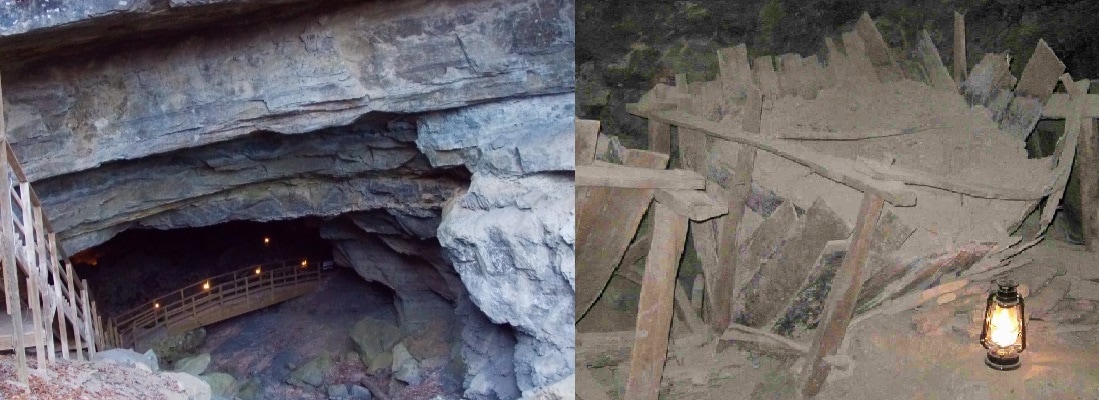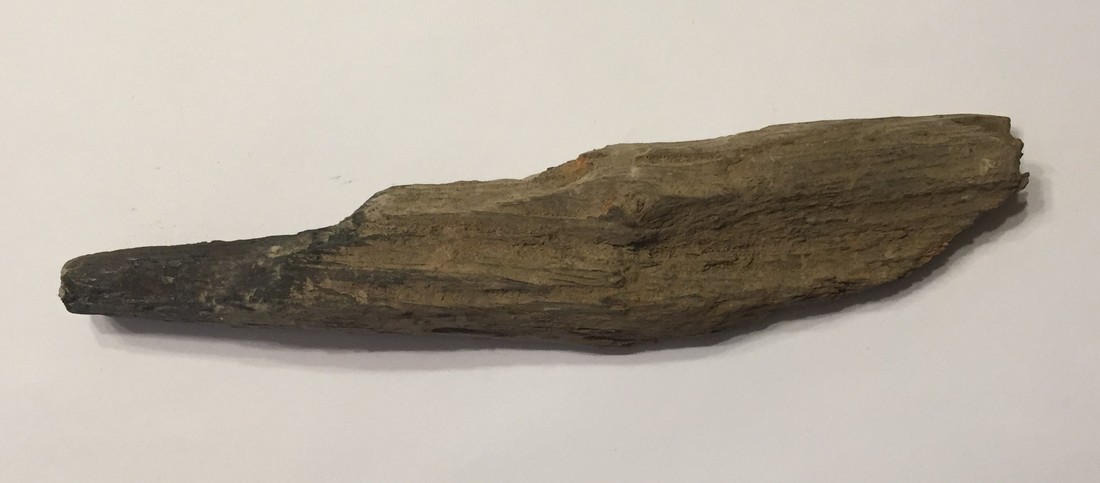Civil War era Pitch Pine Torch from Organ Cave
Confederate General Robert E. Lee was knowledgeable of Organ Cave in Greenbrier County due to having traveled the area on stagecoach. A stream near the entrance was used for watering the horses, and tours of the cave were offered. General Lee had recognized that the cave was rich in Saltpeter and knew how valuable a commodity it was to the military. He also knew that the cave had an internal water source, which was needed for processing the saltpeter into Potassium Nitrate crystals.
During the Civil War, General Lee established a top-secret operation in the cave. During the winter months, the cave, which housed over 1,100 Confederate troops, was used for the mining and processing of Saltpeter. The Chapel Room, located not far from the entrance, was used for church services and social events by the troops.
Some soldiers were designated as “spotters”, who would help locate the saltpeter rich material. The way they would locate material desirable for mining was to go around and press their foot into the soil and mark where they left their boot impression. The following day they would return to the spot and look to see if their boot print was still visible. If the boot print had faded away, the soil was rich in nitrates and marked for mining. If the boot print was still visible, it was too low in saltpeter and would not be mined.
Other troops would then excavate the saltpeter rich material, which was from the section of the cave near the entrance, and use sacks to carry the material ½ mile back in the cave to the Hopper Room. The work was backbreaking! Soldiers had to carry not only the saltpeter laden sacks which weighed between 100 and 150 pounds, but also their rifle and a small pitch pine torch to light their way. Most of the path they had to travel through the cave was on a ledge that was only three to four feet wide. The Confederates were so cautious over protecting their operation that they had sniper sentries hidden at different points within the cave. The troops carrying the saltpeter had to stop at certain locations and make a special hand signal in front of their torch. It the proper hand signal was not observed by the sentry, he was ordered to shoot the man. It is worth noting that a Union Army encampment was actually located above the mine for a period, at the same time Confederate operations in the cave were underway.
Once the saltpeter was taken to the Hopper Room, the material was placed in one of 54 wooden hoppers (37 of which remain intact today), which were lined with straw. Water was then poured over the material. The v-nat hoppers were constructed to funnel the leachate into a trough, which in-turn directed it into a catch trough. The soldiers kept pouring the leachate back through the material until it was thick enough to float an egg. The catch trough then had to be carried the half-mile back to the Chapel Room, where the leachate was further refined, processed and boiled down until only Potassium Nitrate crystals remained. The crystals were laid out on cheesecloth to dry, and then placed and stored in sacks. Once a wagon-load of sacks were accumulated, they would be carried out of the cave under cover of darkness and placed on a wagon for transport to Dublin, Virginia. From Dublin, the crystals were then transported to the powder mills in Augusta, GA, where they were used in the manufacture of gun powder.
At one point, it is believed that the cave helped supply up to 75% of the gunpowder used by the Confederate Army.
The saltpeter operation continued each winter until 1863, when the troops operating in the cave were drawn away to assist in fighting at the Battle of Droop Mountain. The Confederates took a large loss at the battle, and departed the area, and never returned to the cave to resume the saltpeter mining operation. It is a testament to the secrecy of the operation that the United States government remained unaware of the cave’s use by the Confederates until after the Civil War was over.
The artifact in my collection was one of the original Civil War era Pitch Pine Torches that was recovered from the Hopper Room. The current owner of the cave was extremely gracious by allowing me to take the torch for my collection and be able to display it on this on-line museum. The torch is approximately six inches long by one inch wide at its widest point.
During the Civil War, General Lee established a top-secret operation in the cave. During the winter months, the cave, which housed over 1,100 Confederate troops, was used for the mining and processing of Saltpeter. The Chapel Room, located not far from the entrance, was used for church services and social events by the troops.
Some soldiers were designated as “spotters”, who would help locate the saltpeter rich material. The way they would locate material desirable for mining was to go around and press their foot into the soil and mark where they left their boot impression. The following day they would return to the spot and look to see if their boot print was still visible. If the boot print had faded away, the soil was rich in nitrates and marked for mining. If the boot print was still visible, it was too low in saltpeter and would not be mined.
Other troops would then excavate the saltpeter rich material, which was from the section of the cave near the entrance, and use sacks to carry the material ½ mile back in the cave to the Hopper Room. The work was backbreaking! Soldiers had to carry not only the saltpeter laden sacks which weighed between 100 and 150 pounds, but also their rifle and a small pitch pine torch to light their way. Most of the path they had to travel through the cave was on a ledge that was only three to four feet wide. The Confederates were so cautious over protecting their operation that they had sniper sentries hidden at different points within the cave. The troops carrying the saltpeter had to stop at certain locations and make a special hand signal in front of their torch. It the proper hand signal was not observed by the sentry, he was ordered to shoot the man. It is worth noting that a Union Army encampment was actually located above the mine for a period, at the same time Confederate operations in the cave were underway.
Once the saltpeter was taken to the Hopper Room, the material was placed in one of 54 wooden hoppers (37 of which remain intact today), which were lined with straw. Water was then poured over the material. The v-nat hoppers were constructed to funnel the leachate into a trough, which in-turn directed it into a catch trough. The soldiers kept pouring the leachate back through the material until it was thick enough to float an egg. The catch trough then had to be carried the half-mile back to the Chapel Room, where the leachate was further refined, processed and boiled down until only Potassium Nitrate crystals remained. The crystals were laid out on cheesecloth to dry, and then placed and stored in sacks. Once a wagon-load of sacks were accumulated, they would be carried out of the cave under cover of darkness and placed on a wagon for transport to Dublin, Virginia. From Dublin, the crystals were then transported to the powder mills in Augusta, GA, where they were used in the manufacture of gun powder.
At one point, it is believed that the cave helped supply up to 75% of the gunpowder used by the Confederate Army.
The saltpeter operation continued each winter until 1863, when the troops operating in the cave were drawn away to assist in fighting at the Battle of Droop Mountain. The Confederates took a large loss at the battle, and departed the area, and never returned to the cave to resume the saltpeter mining operation. It is a testament to the secrecy of the operation that the United States government remained unaware of the cave’s use by the Confederates until after the Civil War was over.
The artifact in my collection was one of the original Civil War era Pitch Pine Torches that was recovered from the Hopper Room. The current owner of the cave was extremely gracious by allowing me to take the torch for my collection and be able to display it on this on-line museum. The torch is approximately six inches long by one inch wide at its widest point.

